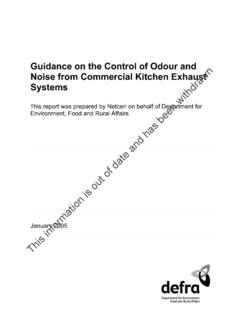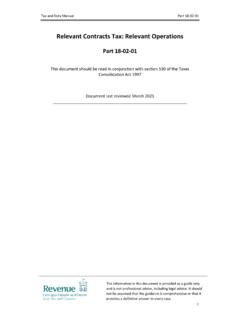Transcription of BC Building Code 2012 - British Columbia
1 BC Building code 2012 . Section ventilation General Application 1) This Section applies to the ventilation of rooms and spaces in residential occupancies by natural ventilation and to self-contained mechanical ventilation systems serving only one dwelling unit or one dwelling unit and a secondary suite. 2) Mechanical ventilation systems other than self-contained systems serving single dwelling units shall conform to Part 6. 3) A storage garage for more than 5 motor vehicles shall be ventilated in accordance with Part 6. Required ventilation Provisions 1) Every dwelling unit shall incorporate provisions for non-heating-season ventilation in accordance with Subsection and, if supplied with electrical power, provisions for heating season ventilation in accordance with Subsection Non-Heating-Season ventilation Required ventilation 1) Rooms or spaces in dwelling units shall be ventilated during the non-heating season by a) natural ventilation in accordance with Article , or b) a mechanical ventilation system conforming to Part 6.
2 2) Where a habitable room or space is not provided with natural ventilation as described in Sentence (1), mechanical ventilation shall be provided to exhaust inside air from or to introduce outside air to that room or space at the rate of a) one-half air change per hour if the room or space is mechanically cooled during the non-heating season, or b) one air change per hour if it is not mechanically cooled during the non-heating season. Natural ventilation 1) The unobstructed openable ventilation area to the outdoors for rooms and spaces in residential buildings ventilated by natural means shall conform to Table Table Natural ventilation Area Forming Part of Sentence (1). Minimum Location Unobstructed Area Bathrooms or water closet rooms m2. Within dwelling Unfinished bathroom space of the floor area unit Dining rooms, living rooms, bedrooms, kitchens, m2 per room or combined rooms, dens, recreation rooms and all other combination room finished rooms Bathrooms or water closet rooms m2 per water- closet Sleeping rooms m2 per occupant Other than within Laundry rooms, kitchens, recreation rooms 4% of the floor area dwelling unit Corridors, storage rooms and other similar public rooms 2% of the floor area or spaces Unfinished basement space not used on a shared basis of the floor area 2) Where a vestibule opens directly off a living or dining room within a dwelling unit, ventilation to the outdoors for such rooms may be through the vestibule.
3 3) Openings for natural ventilation other than windows shall be constructed to provide protection from the weather and insects. 4) Screening shall be of corrosion-resistant material. Heating Season (Mechanical) ventilation (See Appendix A.). Required ventilation 1) Every dwelling unit that is supplied with electrical power shall be provided with a mechanical ventilation system complying with a) CAN/CSA-F326 Residential Mechanical ventilation Systems, . b) a mechanical ventilation system designed in conformance to Part 6, or c) other mechanical ventilation systems as described in this Subsection. Design and Installation 1) Aspects of mechanical ventilation systems not specifically described in this Subsection shall be designed, constructed and installed in accordance with good practice such as described in the ASHRAE.
4 Handbooks and Standards, HRAI Digest, TECA ventilation Guideline, Hydronics Institute Manuals and the SMACNA manuals. Required ventilation Capacity 1) Every dwelling unit shall be equipped with a) a principal ventilation exhaust fan or ducted central ventilation system providing a minimum ventilation rate complying with Table , and b) an exhaust fan with a ventilation rate conforming to Table in every kitchen and bathroom or water-closet room, except that such a fan is not required in the bathroom or water closet room served by the principle ventilation exhaust fan providing that it conforms to the minimum rates of Table 2) Where make-up air is required by Article for the principal ventilation exhaust fan, the maximum ventilation rate shall not exceed 55 l/s (110 cfm). Table Principal Exhaust Fan ventilation Rate Forming Part of Clause (1)(a).
5 Number of Minimum ventilation Rate Bedrooms(1). l/s 1 15. 2 22. 3 30. 4 or more 35. Notes to Table (1). A bedroom is considered as a room with a window conforming to Article , a closet, and an interior closing door. Table Bathroom/Kitchen Exhaust ventilation Rate Forming Part of Clause (1)(b). Exhaust Rate l/s Room Intermittent Continuous Kitchen 40 N/A. Bathroom 25 10. Principal Exhaust Fan Control 1) The principal ventilation exhaust fan shall a) be designed to run continuously, or b) be controlled by an adjustable time control device capable of providing a minimum of two operating periods per day and a total operating time of 8 hrs per day and have a separate manual switch when serving both the principle ventilation exhaust function and a bathroom or water- closet room exhaust function. Principal Exhaust Fan Capacity Rating 1) The principal ventilation exhaust fan capacity rating shall be based on air flow performance at 50.
6 Pa external static pressure as determined in accordance with a) HVI 916 Airflow Test Standard, or b) CAN/CSA-C260-M, Rating the Performance of Residential Mechanical Ventilating Equipment.. Principal Exhaust Fan Sound Rating 1) Wall and ceiling fans used as a principal ventilation exhaust fan shall not have a sound rating exceeding a) Sone when controlled by an adjustable time control device, or b) Sone when designed to run continuously. 2) The principal ventilation exhaust fan sound rating shall be determined by a) HVI 915, Procedure for Loudness Rating of Residential Fan Products, or b) CAN/CSA-C260-M, Rating the Performance of Residential Mechanical Ventilating Equipment.. Kitchen/Bathroom Fan Capacity Ratings 1) Kitchen and bathroom exhaust fan capacity rating shall be based on air flow performance at 50 pa external static pressure as determined in accordance with a) HVI 916 Airflow Test Standard, or b) CAN/CSA-C260-M, Rating the Performance of Residential Mechanical Ventilating Equipment.
7 Required Make-up Air for Principal Exhaust Fan 1) Make-up ventilation air shall be provided from the outdoors where to all dwelling units. a) a dwelling unit contains a naturally aspirating fuel fired vented appliance that is subject to back drafting (See Appendix A), or b) the dwelling unit is located in an area where soil gas is deemed to be a problem and incorporates no soil gas mitigation system . 2) Where mMake-up ventilation air is required, it shall a) when not connected to a forced air heating duct system be sized in accordance with Table for the rating of the principal exhaust fan installed, or 2) When not connected to a forced air heating duct system make-up ventilation air shall be sized in accordance with Table for the rating of the principal exhaust fan installed. b) when connected to the return air duct of a forced air heating appliance, i) have an outdoor air supply duct size of 100 mm diameter for smooth duct or 125 mm diameter for insulated flex duct or equivalent cross-sectional area, and ii) have the outdoor air supply duct connected not more than 5 m or, unless a flow control device is used, less than 3 m upstream of the return air connection to the furnace cabinet, iii) have the furnace air circulating fan interconnected with the principal ventilation exhaust fan, and iv) where the winter design temperature is colder than -10 C, have a duct provided with a motorized damper also interconnected with the principal ventilation exhaust fan.
8 3) When connected to the return air duct of a forced air heating appliance make-up ventilation air shall, a) have an outdoor air supply duct size of 100 mm diameter for smooth duct or 125 mm diameter for insulated flex duct or equivalent cross-sectional area, and b) have the outdoor air supply duct connected i) not more than 5 m or, unless a flow control device is used, less than 3 m upstream of the return air connection to the furnace cabinet, or ii) not less than 3 m from the furnace cabinet where the outdoor air is supplied through an HRV, and c) have the furnace air circulating fan interconnected with the principal ventilation exhaust fan. 4) Except where make-up ventilation air is supplied through an HRV, where the winter design temperature is colder than -10 C the make-up ventilation air duct shall be provided with a motorized damper interconnected with the principal ventilation exhaust fan.
9 5) Where make-up ventilation air is provided as required in Clause (1)(a), in geographic areas where the winter design temperature is warmer than -10 C, it shall may be delivered by a) high level wall or window sash inlets in each bedroom and one common area where i) the heating system is not forced air, ii) the floor area of the dwelling unit is not more than 167 m2, and iii) the dwelling unit contains not more than one storey including stories below grade, or b) ducting into secondary areas such as a utility or storage room, or c) other acceptable methods that will temper the air before it reaches the living, eating and sleeping areas. 4) Where make-up ventilation air is provided as indicated in Clause (1)(a) in geographic areas where the winter design temperature is colder than -10 C, it shall be delivered as described in Sentence (3) with the addition of heat.
10 5) Systems or ducts designed to provide combustion and/or dilution air for fuel burning appliances shall not be used to supply make-up air for ventilation systems. Table Passive Make-up Air Opening Size Forming Part of Sentence (2). Maximum Exhaust Minimum Make-up Air Duct Size ventilation Rate Vent Area Vent Dia. l/s cm2 mm 8 47 80. 12 66 90. 15 85 100. 17 95 110. 20 114 120. 25 142 130. 30 170 150. 35 199 160. 40 227 170. 45 255 180. 50 284 190. 55 312 200. 60 340 210. Exhaust and Make-up Air Ducts 1) Exhaust ducts serving wall or ceiling exhaust fans shall be sized in accordance with Table 2) Exhaust ducts shall discharge directly to the outdoors. 3) Where an exhaust duct passes through or is located adjacent to an unheated space, the duct shall be insulated to not less than RSI 4) Where a ventilation air supply duct passes through a heated space the duct shall be insulated to not less than RSI and provided with an effective vapour barrier.







